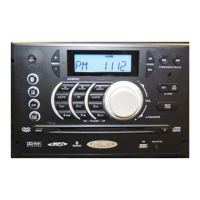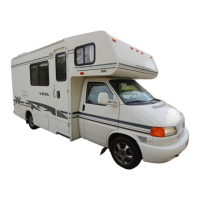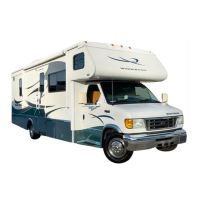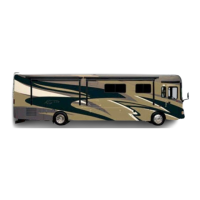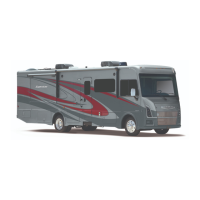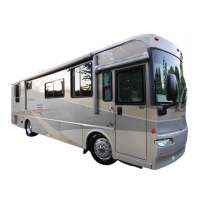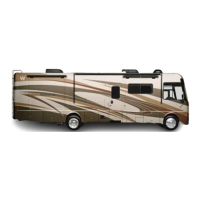Do you have a question about the Winnebago PASEO 48P and is the answer not in the manual?
Explains the purpose and content of the operator's manual for proper care and operation.
Defines safety alert symbols (Danger, Warning, Caution, Notice) used to convey safety precautions.
Outlines the dealer's responsibility for inspecting the motorhome before shipment and delivery.
Advises familiarizing with local regulations impacting RV travel before operating the vehicle.
Recommends checking and adjusting front suspension alignment after loading for optimal steering and tire wear.
Guides owners on obtaining dealer support for information, questions, and maintenance.
Instructs owners on how to report vehicle defects that could cause crashes or injuries to NHTSA and Winnebago.
Describes labels on the driver's door jamb detailing occupant and cargo capacity and weight restrictions.
Explains the data on the vehicle certification label, including VIN, model year, and color codes.
Lists key vehicle specifications such as length, height, weight ratings, and tank capacities.
Provides fields for recording owner, vehicle, and dealer/service center contact details.
Provides essential safety rules for occupying seats, seat belt usage, and using sleeping facilities while the vehicle is moving.
Lists critical pre-driving inspections and precautions for safe operation, including LP gas, tires, and exits.
Details safety precautions for handling fuel and propane, including refueling and leak testing.
Explains how to identify and respond to propane gas leaks, including emergency procedures.
Describes the function of the propane gas leak detector and its alarm system.
Warns about carbon monoxide from exhaust and recommends exhaust system inspection and ventilation.
Explains the CO alarm's purpose and recommends regular testing for proper operation.
Details the smoke alarm's operation, power source, and recommended testing schedule for safety.
Locates the fire extinguisher and advises on its inspection, maintenance, and proper use.
Highlights critical safety rules for handling electrical components, grounding, and circuits to prevent injury.
Advises on securing loose items and being aware of weight limits to prevent dangerous projectiles during stops.
Provides precautions for engine maintenance, jacking the vehicle, and tire selection for safe handling.
Describes the location and operation of the vehicle's five emergency exit doors for safe evacuation.
Advises on ladder safety, weight limits, and warns against using the roof due to slipperiness.
Discusses formaldehyde emissions from materials and potential health effects, recommending ventilation.
Explains mold formation, prevention strategies, health risks, and Winnebago's policy on mold issues.
Provides guidance for handling a flat tire, including safe stopping procedures and tire maintenance checks.
Advises on providing vehicle information to towing services and Winnebago's liability for towing damage.
Details how to use the Battery Boost switch or chassis manual for jump starting the engine.
Instructs on actions to take if the engine overheats, including pulling over and stopping the engine.
Explains how driver and co-pilot seats can be adjusted for individual preference and travel position.
Describes how to swivel the passenger seat to face the living area when the unit is parked.
Emphasizes the importance of seat belts for occupant safety in motion and the need to lock swivel seats.
Details proper lap belt fit, fastening, release, and care to ensure maximum safety protection.
Guides on adjusting power exterior mirrors for maximum rear visibility and using mirror heaters.
Explains the function of the remote keyless entry system for locking and unlocking cab doors.
Describes the purpose of hazard warning flashers for signaling a stopped vehicle on the roadway.
Refers to the chassis manual for operation of dash AC, heater, defroster, and ventilation.
Directs users to the chassis manual for radio features, programming, and operating instructions.
Explains how to use the Battery Boost switch to draw power from house batteries for engine starting.
Discusses the impact of tire pressure on handling, wear, and fuel economy, and the importance of correct replacement.
Covers factory alignment, post-loading adjustments, and the effects of misalignment or imbalance on vehicle performance.
Explains the refrigerator's operation on 12V DC and 110V power, including basic operation and safety warnings.
Explains how to light range top burners and safety precautions for using the propane range.
Refers to the manufacturer's guide for microwave oven operating instructions.
Refers to the manufacturer's guide for microwave/convection oven operating instructions.
Describes the monitor panel for checking tank levels, battery condition, and controlling systems like the generator and water pump.
Refers to Section 6 for generator start/stop and hourmeter instructions.
Explains how to use the battery level switch to check chassis and house battery charge levels.
Details how to activate or deactivate the water pump and provides information on its location.
Explains the function of the roof-mounted solar panel for charging house batteries.
Describes the roof cap for connecting additional solar panels.
Details the ground-level port for connecting portable solar panels.
Explains the PCS for monitoring electrical usage and managing high-energy appliances without overloading circuits.
Describes the propane and 110V heating system for interior warmth and hot water.
Introduces the roof-mounted air conditioning system and its controls.
Provides instructions for operating the air conditioner's cooling mode, temperature control, and louvers.
Advises on checking, cleaning, or replacing the washable air conditioner filters.
Explains the propane system's role in supplying fuel for appliances and its safe operation.
Details the physical state and behavior of propane gas when stored and used.
Describes the horizontally mounted, frame-attached propane tank and its accessibility.
Instructs on the proper procedure for refilling the propane tank at a dealership.
Recommends using straight propane and warns against butane mixtures due to potential appliance damage.
Discusses issues caused by air in the propane tank and the process of purging it.
Explains the low-pressure connection for accessories like BBQ grills and its shut-off valve.
Outlines general safety practices for using the propane system, including safety devices and odor detection.
Lists important warnings, including checking state regulations and precautions for refueling and exhaust inhalation.
Describes how to identify propane leaks and the immediate steps to take if a leak is detected.
Details the regulator's protective cover, vent orientation, and the need for qualified service for adjustments.
Explains the causes and solutions for regulator freeze-ups due to moisture in the fuel.
Discusses how low temperatures affect propane vaporization and the potential for reduced gas pressure.
Highlights critical safety rules for handling electrical components, grounding, and circuits to prevent injury.
Explains the 120V AC system powered by shoreline or generator and its dependent equipment.
Details how to connect the external power cord to an external utility source and associated warnings.
Advises on campground fuses/breakers and contacting park staff if electrical power fails.
Describes the location and function of the power converter in changing AC to DC current.
Explains how the converter charges house batteries and factors affecting charge rate.
Describes the converter's thermal overload protection and its reset mechanism.
Explains how the breaker panel protects 120V components from overloads and shorts.
Mentions the provision of standard household electrical outlets throughout the coach.
Explains the GFCI's role in protecting against severe electrical shock for specific outlets.
Details the GFCI outlet's test and reset functions and limitations in preventing shock.
Covers generator operation, including automatic power transfer and safety precautions for handling.
Explains how to read the generator hourmeter for maintenance tracking.
Describes the 12V DC system components: chassis battery, house batteries, and power converter.
Refers to the "Power Center" section for converter information.
Explains the chassis battery's role in starting the engine and powering accessories.
Details the deep-cycle house batteries for powering 12V equipment and emergency starting.
Explains the switch's function to disconnect house batteries during storage and avoid drain.
Indicates the location of house batteries for accessibility.
Provides essential guidance on battery care, preventing sulfating, and maintaining charge during storage.
Continues battery care instructions, including terminal tightening, cleaning, and specific precautions.
Explains how 12V circuits are protected by fuses or breakers and how to reset/replace them.
Mentions the fuse panel accepting blade-type fuses and the importance of correct rating.
Describes the fresh water system's function, water sources, and methods for filling the fresh water tank.
Recommends using pressure regulators to protect system components from high city water pressure.
Details the procedure for filling the fresh water tank using the external tank fill inlet.
Explains how to fill the fresh water tank using the gravity fill port.
Describes how connecting to city water bypasses the pump and supplies water directly to fixtures.
Outlines the steps for safely disconnecting from the city water supply.
Explains the function of the demand pump for supplying water from the tank when city water is not connected.
Describes the pump's strainer for capturing particles and recommends its cleaning.
Locates the water pump switch and advises turning it off when away from the vehicle.
Provides a step-by-step guide for priming the water system for first-time use.
Explains the function of the cold water filter at the galley sink for taste-free drinking water.
Advises on when and how to replace the cold water filter cartridge.
Repeats information about the cold water filter's function and location.
Provides a procedure for disinfecting the potable water system using chlorine bleach via the gravity fill port.
Details a method for disinfecting the tank by connecting to city water and using an inline filter.
Offers an alternate method for disinfecting the tank and hose using a funnel and city water hydrant.
Explains the normal dripping from the shower hose after use due to vacuum release.
Locates the shower drain pump switch and describes its operation for removing water from the shower floor.
Describes the shower drain strainer and filter and recommends periodic cleaning.
Mentions the shower pump filter screen and its cleaning needs.
Explains the normal dripping from shower heads/faucets due to pressure bleed-off.
Describes the operation of the folding lavatory sink in the bathroom.
Explains the use of the exterior wash station for rinsing and outdoor cleaning.
Describes the motorhome toilet's design and operation, including important "don'ts".
Explains the self-contained drainage system with black and gray water holding tanks.
Describes the 12V waste pump for transferring gray tank waste and accessing it.
Provides a step-by-step guide for draining and dumping the black and gray water holding tanks.
Details the procedure for rinsing the inside of the black waste holding tank after dumping.
Advises on using sewer hook-ups and maintaining dump valves for proper tank function.
Explains the purpose of waterline and tank drain valves for storage and sanitizing.
Locates and describes the bypass valve for easier winterization of the water heater.
Begins a detailed procedure for winterizing the water system using compressed air.
Details draining water and purging lines with compressed air for winterization.
Guides on setting up winterization valves, draining the water heater, and installing diverter plugs.
Explains connecting air pressure and running it through the system for blow-out winterization.
Instructs on removing water filter cartridges before winterizing.
Details the procedure for filling plumbing lines with non-toxic RV antifreeze for winterization.
Continues instructions for setting up winterization valves and draining the water heater.
Describes the antifreeze siphon tube and winterization port for filling lines with antifreeze.
Explains how to fill water lines with antifreeze by opening faucets and the shower/wash station.
Details turning off the water pump, setting the winterization valve, and replacing caps.
Instructs on pouring antifreeze into drains to fill trap pipes and prevent odors.
Guides on draining holding tanks at a disposal site and closing drain valves.
Provides a chart listing the locations of various water system drain valves.
Explains that the LED TV is powered by 12V DC current and requires the TV Master Power switch to be ON.
Describes the TV swing-out mechanism for adjusting viewing angles.
Refers to a separate guide for basic operation of the audio/video system.
Details features and operation of the multi-function DVD player, including Bluetooth and alarm clock.
Guides on setting the TV video input to HDMI for DVD player connection.
Explains how to insert a DVD, load it, and play it, including skipping previews.
Instructs on routing TV stereo sound output to the Deluxe Sound speakers via HDMI ARC.
Describes the exterior speakers for outdoor listening and how to connect them to the interior stereo.
Explains the digital antenna's capability for clear HD reception and its built-in amplifier.
Provides step-by-step instructions for operating the digital TV antenna and signal meter.
Mentions the TV signal amplifier built into the antenna, controlled by a power switch.
Locates the cable television input connection on the driver sidewall.
Describes the exterior connection for TV and 12V devices for outdoor entertainment.
Mentions the composite connection near the TV for connecting audio/video components.
Warns that sleeping facilities are not for use while the vehicle is in motion and requires seat belts.
Explains how to convert the dinette into additional sleeping space by lowering the table and arranging cushions.
Describes the multi-positioning window shades and screens for light filtering, airflow, and privacy.
Discusses the natural beauty of wood, Winnebago's craftsmanship, and the characteristics of oak, maple, and cherry woods.
Continues discussion on wood characteristics, aging, and warranty coverage for natural variations.
Emphasizes the importance of inspecting and maintaining sealants to prevent water entry and damage.
Warns against being on the roof and advises immediate repair of any roof damage or detached sealant.
Advises on cleaning the undercarriage to prevent rust and corrosion and maintain load capacity.
Provides precautions for preserving the exterior's gloss and durability, including parking and driving tips.
Advises on parking locations to avoid damage from trees, salt spray, or industrial fallout.
Recommends rinsing off spills on plastic surfaces, decals, and appliques immediately.
Details frequent washing recommendations, suitable detergents, and precautions for using pressure washers.
Guides on cleaning plastic parts with mild cleaners, listing safe and damaging agents.
Advises on cleaning exterior lamp lenses, especially headlights, with soap and water to prevent damage.
Recommends weekly vacuuming of fabrics and carpet to prevent dirt accumulation and wear.
Discusses fabric care, potential damage from cleaning products, and advises testing products on hidden areas.
Describes the characteristics of Ultraleather upholstery and recommends spot treatment for soils and stains.
Provides a chart detailing cleaning methods for various stains on Ultraleather upholstery.
Advises cleaning vinyl with a soft, damp cloth and mild detergent, avoiding solvents.
Recommends professional dry cleaning for these fabric items, noting potential shrinkage.
Emphasizes prompt response to stains with appropriate cleaners for best results.
Guides on cleaning wooden and vinyl cabinetry using appropriate cleaning products.
Advises cleaning vinyl wall paneling with mild detergent and warm water, avoiding harsh chemicals.
Recommends using wax on laminate surfaces for preservation and ease of cleaning.
Details care and maintenance for Corian countertops, suggesting warm soapy water or ammonia-based cleaners.
Provides care and cleaning instructions for stainless steel sinks, including avoiding steel wool and contact with harsh chemicals.
Refers to appliance manufacturer manuals for care and appearance maintenance.
Offers recommendations for maintaining vinyl flooring, including daily sweeping and occasional deep cleaning.
Lists common stains and methods for their removal from vinyl flooring.
Refers to the InfoCase for toilet care instructions and provides cleaning advice for tub/shower walls and lavatory sinks.
Advises on cleaning windows and doors and lubricating locks/hinges.
Outlines steps for preparing the vehicle for storage to minimize damage, including cleaning and charging batteries.
Details procedures for removing the vehicle from storage, including airing it out and checking systems.
Refers to the chassis manual for operating safety, service recommendations, and maintenance schedules.
Presents a chart detailing recommended maintenance intervals for various coach systems.
Continues the maintenance chart, covering safety equipment, appliances, and filters.
Completes the maintenance chart, detailing sealant, frame, chassis, tire, and miscellaneous item checks.
Provides guidance on load capacity, securing items, and distributing cargo to avoid exceeding weight ratings.
Explains how to weigh the loaded coach at a commercial scale to check load distribution.
Details the process of taking three separate weights (front axle, whole vehicle, rear axle) for load distribution.
Describes the method of weighing each corner of the coach to determine side-to-side weight distribution.
Covers hitch capacity, tongue weight, and exceeding vehicle weight ratings when towing.
Mentions the pre-wired connectors for trailer or car towing lights and the trailer brake controller connector.
Defines GVWR and GAWR and emphasizes maintaining proper trailer weight distribution for safe towing.
Defines GCWR as the maximum allowable weight of the motorhome and loaded trailer.
Explains SAE standards for hitch ratings and vertical tongue load recommendations.
Refers to the chassis manual for window operating instructions.
Describes the power roof ventilator and its dome crank knob operation.
Provides instructions for operating the ceiling ventilator, including lid opening, fan speeds, and airflow direction.
Details the operation of the power roof ventilator, including ON/OFF, direction control, AUTO mode, and vent lid adjustment.
Describes the operation of the bathroom power roof ventilator using a fan power switch.
Explains the operation of the running board accent lights via the Front AUX switch.
Details the operation of the power awning and its light, including the ignition lockout system.
Describes how to use the supplied bike rack, including lifting stabilizers, releasing retention brackets, and securing bikes.
Provides safety warnings and instructions for using the ladder, including inspection and weight limits.
Details the steps to remove the ladder from its storage position and mount it on the roof rail.
Mentions the luggage rack's maximum capacity and weight distribution for roof rails.
Discusses condensation and humidity issues during extended occupancy and methods to reduce moisture.
Explains the purpose and content of the operator's manual for proper care and operation.
Defines safety alert symbols (Danger, Warning, Caution, Notice) used to convey safety precautions.
Outlines the dealer's responsibility for inspecting the motorhome before shipment and delivery.
Advises familiarizing with local regulations impacting RV travel before operating the vehicle.
Recommends checking and adjusting front suspension alignment after loading for optimal steering and tire wear.
Guides owners on obtaining dealer support for information, questions, and maintenance.
Instructs owners on how to report vehicle defects that could cause crashes or injuries to NHTSA and Winnebago.
Describes labels on the driver's door jamb detailing occupant and cargo capacity and weight restrictions.
Explains the data on the vehicle certification label, including VIN, model year, and color codes.
Lists key vehicle specifications such as length, height, weight ratings, and tank capacities.
Provides fields for recording owner, vehicle, and dealer/service center contact details.
Provides essential safety rules for occupying seats, seat belt usage, and using sleeping facilities while the vehicle is moving.
Lists critical pre-driving inspections and precautions for safe operation, including LP gas, tires, and exits.
Details safety precautions for handling fuel and propane, including refueling and leak testing.
Explains how to identify and respond to propane gas leaks, including emergency procedures.
Describes the function of the propane gas leak detector and its alarm system.
Warns about carbon monoxide from exhaust and recommends exhaust system inspection and ventilation.
Explains the CO alarm's purpose and recommends regular testing for proper operation.
Details the smoke alarm's operation, power source, and recommended testing schedule for safety.
Locates the fire extinguisher and advises on its inspection, maintenance, and proper use.
Highlights critical safety rules for handling electrical components, grounding, and circuits to prevent injury.
Advises on securing loose items and being aware of weight limits to prevent dangerous projectiles during stops.
Provides precautions for engine maintenance, jacking the vehicle, and tire selection for safe handling.
Describes the location and operation of the vehicle's five emergency exit doors for safe evacuation.
Advises on ladder safety, weight limits, and warns against using the roof due to slipperiness.
Discusses formaldehyde emissions from materials and potential health effects, recommending ventilation.
Explains mold formation, prevention strategies, health risks, and Winnebago's policy on mold issues.
Provides guidance for handling a flat tire, including safe stopping procedures and tire maintenance checks.
Advises on providing vehicle information to towing services and Winnebago's liability for towing damage.
Details how to use the Battery Boost switch or chassis manual for jump starting the engine.
Instructs on actions to take if the engine overheats, including pulling over and stopping the engine.
Explains how driver and co-pilot seats can be adjusted for individual preference and travel position.
Describes how to swivel the passenger seat to face the living area when the unit is parked.
Emphasizes the importance of seat belts for occupant safety in motion and the need to lock swivel seats.
Details proper lap belt fit, fastening, release, and care to ensure maximum safety protection.
Guides on adjusting power exterior mirrors for maximum rear visibility and using mirror heaters.
Explains the function of the remote keyless entry system for locking and unlocking cab doors.
Describes the purpose of hazard warning flashers for signaling a stopped vehicle on the roadway.
Refers to the chassis manual for operation of dash AC, heater, defroster, and ventilation.
Directs users to the chassis manual for radio features, programming, and operating instructions.
Explains how to use the Battery Boost switch to draw power from house batteries for engine starting.
Discusses the impact of tire pressure on handling, wear, and fuel economy, and the importance of correct replacement.
Covers factory alignment, post-loading adjustments, and the effects of misalignment or imbalance on vehicle performance.
Explains the refrigerator's operation on 12V DC and 110V power, including basic operation and safety warnings.
Explains how to light range top burners and safety precautions for using the propane range.
Refers to the manufacturer's guide for microwave oven operating instructions.
Refers to the manufacturer's guide for microwave/convection oven operating instructions.
Describes the monitor panel for checking tank levels, battery condition, and controlling systems like the generator and water pump.
Refers to Section 6 for generator start/stop and hourmeter instructions.
Explains how to use the battery level switch to check chassis and house battery charge levels.
Details how to activate or deactivate the water pump and provides information on its location.
Explains the function of the roof-mounted solar panel for charging house batteries.
Describes the roof cap for connecting additional solar panels.
Details the ground-level port for connecting portable solar panels.
Explains the PCS for monitoring electrical usage and managing high-energy appliances without overloading circuits.
Describes the propane and 110V heating system for interior warmth and hot water.
Introduces the roof-mounted air conditioning system and its controls.
Provides instructions for operating the air conditioner's cooling mode, temperature control, and louvers.
Advises on checking, cleaning, or replacing the washable air conditioner filters.
Explains the propane system's role in supplying fuel for appliances and its safe operation.
Details the physical state and behavior of propane gas when stored and used.
Describes the horizontally mounted, frame-attached propane tank and its accessibility.
Instructs on the proper procedure for refilling the propane tank at a dealership.
Recommends using straight propane and warns against butane mixtures due to potential appliance damage.
Discusses issues caused by air in the propane tank and the process of purging it.
Explains the low-pressure connection for accessories like BBQ grills and its shut-off valve.
Outlines general safety practices for using the propane system, including safety devices and odor detection.
Lists important warnings, including checking state regulations and precautions for refueling and exhaust inhalation.
Describes how to identify propane leaks and the immediate steps to take if a leak is detected.
Details the regulator's protective cover, vent orientation, and the need for qualified service for adjustments.
Explains the causes and solutions for regulator freeze-ups due to moisture in the fuel.
Discusses how low temperatures affect propane vaporization and the potential for reduced gas pressure.
Highlights critical safety rules for handling electrical components, grounding, and circuits to prevent injury.
Explains the 120V AC system powered by shoreline or generator and its dependent equipment.
Details how to connect the external power cord to an external utility source and associated warnings.
Advises on campground fuses/breakers and contacting park staff if electrical power fails.
Describes the location and function of the power converter in changing AC to DC current.
Explains how the converter charges house batteries and factors affecting charge rate.
Describes the converter's thermal overload protection and its reset mechanism.
Explains how the breaker panel protects 120V components from overloads and shorts.
Mentions the provision of standard household electrical outlets throughout the coach.
Explains the GFCI's role in protecting against severe electrical shock for specific outlets.
Details the GFCI outlet's test and reset functions and limitations in preventing shock.
Covers generator operation, including automatic power transfer and safety precautions for handling.
Explains how to read the generator hourmeter for maintenance tracking.
Describes the 12V DC system components: chassis battery, house batteries, and power converter.
Refers to the "Power Center" section for converter information.
Explains the chassis battery's role in starting the engine and powering accessories.
Details the deep-cycle house batteries for powering 12V equipment and emergency starting.
Explains the switch's function to disconnect house batteries during storage and avoid drain.
Indicates the location of house batteries for accessibility.
Provides essential guidance on battery care, preventing sulfating, and maintaining charge during storage.
Continues battery care instructions, including terminal tightening, cleaning, and specific precautions.
Explains how 12V circuits are protected by fuses or breakers and how to reset/replace them.
Mentions the fuse panel accepting blade-type fuses and the importance of correct rating.
Describes the fresh water system's function, water sources, and methods for filling the fresh water tank.
Recommends using pressure regulators to protect system components from high city water pressure.
Details the procedure for filling the fresh water tank using the external tank fill inlet.
Explains how to fill the fresh water tank using the gravity fill port.
Describes how connecting to city water bypasses the pump and supplies water directly to fixtures.
Outlines the steps for safely disconnecting from the city water supply.
Explains the function of the demand pump for supplying water from the tank when city water is not connected.
Describes the pump's strainer for capturing particles and recommends its cleaning.
Locates the water pump switch and advises turning it off when away from the vehicle.
Provides a step-by-step guide for priming the water system for first-time use.
Explains the function of the cold water filter at the galley sink for taste-free drinking water.
Advises on when and how to replace the cold water filter cartridge.
Repeats information about the cold water filter's function and location.
Provides a procedure for disinfecting the potable water system using chlorine bleach via the gravity fill port.
Details a method for disinfecting the tank by connecting to city water and using an inline filter.
Offers an alternate method for disinfecting the tank and hose using a funnel and city water hydrant.
Explains the normal dripping from the shower hose after use due to vacuum release.
Locates the shower drain pump switch and describes its operation for removing water from the shower floor.
Describes the shower drain strainer and filter and recommends periodic cleaning.
Mentions the shower pump filter screen and its cleaning needs.
Explains the normal dripping from shower heads/faucets due to pressure bleed-off.
Describes the operation of the folding lavatory sink in the bathroom.
Explains the use of the exterior wash station for rinsing and outdoor cleaning.
Describes the motorhome toilet's design and operation, including important "don'ts".
Explains the self-contained drainage system with black and gray water holding tanks.
Describes the 12V waste pump for transferring gray tank waste and accessing it.
Provides a step-by-step guide for draining and dumping the black and gray water holding tanks.
Details the procedure for rinsing the inside of the black waste holding tank after dumping.
Advises on using sewer hook-ups and maintaining dump valves for proper tank function.
Explains the purpose of waterline and tank drain valves for storage and sanitizing.
Locates and describes the bypass valve for easier winterization of the water heater.
Begins a detailed procedure for winterizing the water system using compressed air.
Details draining water and purging lines with compressed air for winterization.
Guides on setting up winterization valves, draining the water heater, and installing diverter plugs.
Explains connecting air pressure and running it through the system for blow-out winterization.
Instructs on removing water filter cartridges before winterizing.
Details the procedure for filling plumbing lines with non-toxic RV antifreeze for winterization.
Continues instructions for setting up winterization valves and draining the water heater.
Describes the antifreeze siphon tube and winterization port for filling lines with antifreeze.
Explains how to fill water lines with antifreeze by opening faucets and the shower/wash station.
Details turning off the water pump, setting the winterization valve, and replacing caps.
Instructs on pouring antifreeze into drains to fill trap pipes and prevent odors.
Guides on draining holding tanks at a disposal site and closing drain valves.
Provides a chart listing the locations of various water system drain valves.
Explains that the LED TV is powered by 12V DC current and requires the TV Master Power switch to be ON.
Describes the TV swing-out mechanism for adjusting viewing angles.
Refers to a separate guide for basic operation of the audio/video system.
Details features and operation of the multi-function DVD player, including Bluetooth and alarm clock.
Guides on setting the TV video input to HDMI for DVD player connection.
Explains how to insert a DVD, load it, and play it, including skipping previews.
Instructs on routing TV stereo sound output to the Deluxe Sound speakers via HDMI ARC.
Describes the exterior speakers for outdoor listening and how to connect them to the interior stereo.
Explains the digital antenna's capability for clear HD reception and its built-in amplifier.
Provides step-by-step instructions for operating the digital TV antenna and signal meter.
Mentions the TV signal amplifier built into the antenna, controlled by a power switch.
Locates the cable television input connection on the driver sidewall.
Describes the exterior connection for TV and 12V devices for outdoor entertainment.
Mentions the composite connection near the TV for connecting audio/video components.
Warns that sleeping facilities are not for use while the vehicle is in motion and requires seat belts.
Explains how to convert the dinette into additional sleeping space by lowering the table and arranging cushions.
Describes the multi-positioning window shades and screens for light filtering, airflow, and privacy.
Discusses the natural beauty of wood, Winnebago's craftsmanship, and the characteristics of oak, maple, and cherry woods.
Continues discussion on wood characteristics, aging, and warranty coverage for natural variations.
Emphasizes the importance of inspecting and maintaining sealants to prevent water entry and damage.
Warns against being on the roof and advises immediate repair of any roof damage or detached sealant.
Advises on cleaning the undercarriage to prevent rust and corrosion and maintain load capacity.
Provides precautions for preserving the exterior's gloss and durability, including parking and driving tips.
Advises on parking locations to avoid damage from trees, salt spray, or industrial fallout.
Recommends rinsing off spills on plastic surfaces, decals, and appliques immediately.
Details frequent washing recommendations, suitable detergents, and precautions for using pressure washers.
Guides on cleaning plastic parts with mild cleaners, listing safe and damaging agents.
Advises on cleaning exterior lamp lenses, especially headlights, with soap and water to prevent damage.
Recommends weekly vacuuming of fabrics and carpet to prevent dirt accumulation and wear.
Discusses fabric care, potential damage from cleaning products, and advises testing products on hidden areas.
Describes the characteristics of Ultraleather upholstery and recommends spot treatment for soils and stains.
Provides a chart detailing cleaning methods for various stains on Ultraleather upholstery.
Advises cleaning vinyl with a soft, damp cloth and mild detergent, avoiding solvents.
Recommends professional dry cleaning for these fabric items, noting potential shrinkage.
Emphasizes prompt response to stains with appropriate cleaners for best results.
Guides on cleaning wooden and vinyl cabinetry using appropriate cleaning products.
Advises cleaning vinyl wall paneling with mild detergent and warm water, avoiding harsh chemicals.
Recommends using wax on laminate surfaces for preservation and ease of cleaning.
Details care and maintenance for Corian countertops, suggesting warm soapy water or ammonia-based cleaners.
Provides care and cleaning instructions for stainless steel sinks, including avoiding steel wool and contact with harsh chemicals.
Refers to appliance manufacturer manuals for care and appearance maintenance.
Offers recommendations for maintaining vinyl flooring, including daily sweeping and occasional deep cleaning.
Lists common stains and methods for their removal from vinyl flooring.
Refers to the InfoCase for toilet care instructions and provides cleaning advice for tub/shower walls and lavatory sinks.
Advises on cleaning windows and doors and lubricating locks/hinges.
Outlines steps for preparing the vehicle for storage to minimize damage, including cleaning and charging batteries.
Details procedures for removing the vehicle from storage, including airing it out and checking systems.
Refers to the chassis manual for operating safety, service recommendations, and maintenance schedules.
Presents a chart detailing recommended maintenance intervals for various coach systems.
Continues the maintenance chart, covering safety equipment, appliances, and filters.
Completes the maintenance chart, detailing sealant, frame, chassis, tire, and miscellaneous item checks.
Provides guidance on load capacity, securing items, and distributing cargo to avoid exceeding weight ratings.
Explains how to weigh the loaded coach at a commercial scale to check load distribution.
Details the process of taking three separate weights (front axle, whole vehicle, rear axle) for load distribution.
Describes the method of weighing each corner of the coach to determine side-to-side weight distribution.
Covers hitch capacity, tongue weight, and exceeding vehicle weight ratings when towing.
Mentions the pre-wired connectors for trailer or car towing lights and the trailer brake controller connector.
Defines GVWR and GAWR and emphasizes maintaining proper trailer weight distribution for safe towing.
Defines GCWR as the maximum allowable weight of the motorhome and loaded trailer.
Explains SAE standards for hitch ratings and vertical tongue load recommendations.
Refers to the chassis manual for window operating instructions.
Describes the power roof ventilator and its dome crank knob operation.
Provides instructions for operating the ceiling ventilator, including lid opening, fan speeds, and airflow direction.
Details the operation of the power roof ventilator, including ON/OFF, direction control, AUTO mode, and vent lid adjustment.
Describes the operation of the bathroom power roof ventilator using a fan power switch.
Explains the operation of the running board accent lights via the Front AUX switch.
Details the operation of the power awning and its light, including the ignition lockout system.
Describes how to use the supplied bike rack, including lifting stabilizers, releasing retention brackets, and securing bikes.
Provides safety warnings and instructions for using the ladder, including inspection and weight limits.
Details the steps to remove the ladder from its storage position and mount it on the roof rail.
Mentions the luggage rack's maximum capacity and weight distribution for roof rails.
Discusses condensation and humidity issues during extended occupancy and methods to reduce moisture.
| Brand | Winnebago |
|---|---|
| Model | PASEO 48P |
| Category | Motorhomes |
| Language | English |


